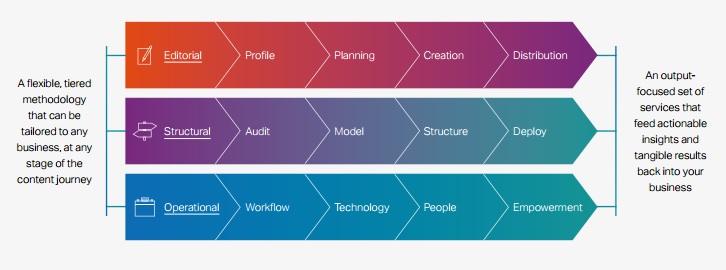Content marketing is playing an ever more important part in the marketing mix, but how can it enhance customer experience? This new white paper from Amaze offers five steps to get the most out of content marketing.
This best practice guide “unlocking content strategy to drive superior customer experience”. identifies the role content plays in enhancing the overall customer experience, as well as the key steps for developing and implementing an effective content strategy, including a newly developed content maturity model.
The Content Marketing Institute’s 2016 annual report revealed that although 99% of marketers are committed to their current content programmes, only one third say their organisations are effective in their use of content. This is indicative of the fact that many businesses are yet to view content as a strategic asset.
Amaze’s white paper addresses the fact that while a purely tactical approach to content can work in the short-term, it fails to address the wider challenges faced. However, if approached correctly, content can be elemental to business success. The key to this lies in originating an overarching, company-wide content strategy, rather than focusing on the more tactical elements.
The path to becoming a content led business is not necessarily a neat, linear, growth sequence but Amaze believes all organisations should be working towards a final goal of becoming a truly content-led business. This latest white paper includes Amaze’s newly developed content maturity model, to help organisations assess where they are on their content journey, as well as five practical steps for developing an effective content strategy. These steps can be summarised as follows:
1. Start with your story
It’s not enough for people to know your brand name; they need to know what you stand for. Consumers look for meaning when forming an attachment to a brand. Content conveys meaning through values and commitments. But, storytelling is not intended to be a selling tool. The whole point of customer-centric content is that it goes beyond products and builds affinity between the brand and the user.
2. Know your audience
In order to genuinely create content that customers care about it’s vital you understand them well. There is a wealth of data that can build the picture of the specific people you’re trying to reach. Insights must go beyond age and demographic and delve into attitudes and behaviours to allow a 360° picture of persona preferences to be formed.
3. Plan your content
With so many channels to consider, there is recognition that good customer experience relies on delivering interesting, relevant and personalised content across all channels seamlessly. The outcome of good content planning is the understanding of how the content will be prioritised, organised, formatted and displayed.
4. Align people and process
People are perhaps the most important element in any content strategy as attitudes and behaviours are as important as any working practices. After all, content is not just a marketing issue – it permeates multiple departments and when they act collaboratively and in harmony, it can work like clockwork.
5. Engage your leaders
The more business leaders understand the value of content strategy, the more willing they’ll be to invest in it. C-Suite involvement provides internal advocacy for content strategy initiatives by supporting the drive for enterprise-wide planning and providing strategic governance.
Sandra McDowell, Managing Director, Communications Practice at Amaze, comments: “Though organisations are recognising the importance of devoting time, effort and resource to content generation, many are still struggling to manage content effectively. Devising and implementing a content strategy can seem daunting as there will be thorny issues to deal with and difficult questions to ask. But the benefits of providing the business with focus, consistency, efficiency and measurable value will make it worthwhile. By creating an effective content strategy, organisations will have a blueprint for the ordered, thoughtful and creative use of content; giving long-term control over how a brand projects itself. It’s also the model that underpins all content design – technical, functional and visual. It goes beyond content. It’s all about aligning people, processes and technologies with business goals and customer needs.
“The content maturity model is a really practical guide we’ve designed to help any organisation define where they are on their content journey – from the most basic use of content right through to the point where content is at the heart of everything they do. It’s a great way to see the challenges and opportunities that exist and can provide a roadmap to build and grow content capabilities. Knowing where you are on this journey is a significant part of starting the process of defining a content strategy.”
<
